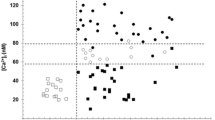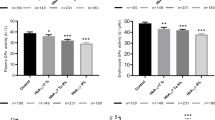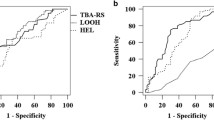Abstract
Background and aims: One of the factors playing a role in both the aging process and the etiopathogenesis of primary hypertension is oxidative stress. The purpose of this work was to estimate the production of nitric oxide (NO), oxidase activity of ceruloplasmin (Cp) and level of malondialdehyde (MDA), the end-product of lipid peroxidation in the blood of elderly patients with primary hypertension. The influence of treatment with the angiotensin-con-verting enzyme inhibitor perindopril (P) on the above parameters was also ascertained. Methods: The study was carried out on 37 patients (69–91 yrs) with primary hypertension, treated with perindopril for 6 weeks, and normotensive subjects who constituted the two control groups: 25 (65–96 yrs — K1)and 23 (22–41 yrs — K2). Cp oxidase activity in serum, MDA level expressed as the concentration of substances reacting to thiobarbituric acid in red blood cells, and production of NO (concentration of nitrite/nitrate in plasma) by the Griess reaction were all determined. Results: In the group of patients with hypertension, Cp activity was significantly higher than that in the control groups (K1 and K2). MDA concentrations in the erythrocytes of patients with hypertension were significantly higher than in the control groups and hypertensive patients had a lower NO (nitrite/nitrate) levels in plasma when compared with controls. In patients with hypertension, after only 7 days of therapy a substantial decrease in Cp oxidative activity was found, although the lowest value was observed after 6 weeks of therapy. Nevertheless, significantly lower MDA was observed after 6 weeks of therapy, corresponding to the values obtained in controls (K1 and K2). After 6 weeks of perindopril therapy, NO (nitrite/nitrate) was statistically higher in comparison with the values obtained before therapy. Conclusions: Results confirm intensification of oxidative stress and disorders in the production of NO in elderly patients with primary hypertension, and indicate the beneficial antioxidant effect of P.
Similar content being viewed by others
References
Kannel W, Gordon T, Schwartz MJ. Systolic versus diastolic blood pressure and risk of coronary artery disease: the Framingham Study. Am J Cardiol 1971; 27: 335–46.
Forette B. Hypertension in very old subjects. Clin Exp Hypertens 1999; 21: 917–25.
Soltis EF. Effect of age on blood pressure and membrane dependent vascular responses in the rat. Circ Res 1987; 61: 889- 97.
Taddei S, Virdis A, Mattei P, et al. Aging and endothelial function in normotensive subjects and essential hypertensive patients. Circulation 1995; 91: 1981–7.
Harman D. Aging: a theory based on free radical and radiation chemistry. J Gerontol 1956; 11: 298–300.
Cai H, Harrison DG. Endothelial dysfunction in cardiovascular diseases: the role of oxidant stress. Circ Res 2000; 87: 840–4.
Zalba G, Beaumont FJ, San Jose G, Fortuno A, Fortuno MA, Diez J. Is the balance between nitric oxide and Superoxide altered in spontaneously hypertensive rats with endothelial dysfunction? Nephrol Dial Transplant 2001; 16 (Suppl 1): 2–5.
Li PF, Dietz R, von Harsdorf R. Differential effect of hydrogen peroxide and Superoxide anion on apoptosis and proliferation of vascular smooth muscle cells. Circulation 1997; 96: 3602–9.
Romero JC, Reckelhoff JF. Role of angiotensin and oxidative stress in essential hypertension. Hypertension 1999; 34 (Part 2): 943–9.
Kajda G, Harrison D. Interactions between NO and reactive oxygen species pathophysiological importance in atherosclerosis, hypertension, diabetes and heart failure. Cardiovasc Res 1999; 43: 562–71.
Liao DF, Chen X. Prostacyclin-mediated protection by angiotensin-converting enzyme inhibitors against injury of aortic en-dothelium by free-radicals. Cardioscience 1992; 3: 79–84.
Bartosz M, Kedziora J, Bartosz G. Antioxidant and prooxidant properties of captopril and enalapril. Free Rad Biol Med 1997; 23: 729–35.
Fox PL, Mazumder P, Ehrenwald E, Mukhopadyay CK. Ceruloplasmin and cardiovascular disease. Free Rad Biol Med 2000; 12: 1735–47.
Chobanian AV, Bakris GL, Black HR, et al. The Seventh Report of the Joint National Committee on Prevention, Detection, Evaluation and Treatment of High Blood Preassure. JAMA 2003; 289: 2560–72.
Ravin H. An improved colorimetric enzymatic assay of ceruloplasmin. J Lab Clin Med 1961; 58/1: 161–8.
Placer Z, Cushiman Z, Jonson B. Estimation of products of lipid peroxidation, malondialdehyde, in biochemical systems. Anal Biochem 1966; 16: 359–64.
Marietta MA, Yoon PS, Iyengar R, Leaf CD, Wishnok JS. Macrophage oxidation of L-arginine to nitrite and nitrate. Nitric oxide is an intermediate. Biochemistry 1988; 27: 8706–11.
Pryor WA. Oxy-radicals and related species: their formation, lifetimes and reactions. Annu Rev Physiol 1986; 48: 209–14.
Kocemba J, Gryglewska B, Klich A, Grodzicki T. Distribution of blood pressure and prevalence of arterial hypertension in the old population of Cracow. Mat Med Pol 1991; 1: 33–5.
Schöneich C. Reactive oxygen species and biological aging: a mechanistic approach. Exp Gerontol 1999; 34: 19–34.
Gil P, Farinas F, Casado A, Lopez-Fernandez E. Malondialdehyde: possible marker of aging. Gerontology 2002; 48: 209–14.
Ershler WB, Keller FT. Age-associated increased interleukin 6 gene expression, late-life diseases and frailty. Annu Rev Med 2000; 51: 245–70.
Cutler RG. Antioxidants and aging. Am J Clin Nutr 2002; 53: 373S–9S.
Ruiz-Ortega M, Lorenzo O, Ruperez M, et al. Role of the reninangiotensin system in vascular diseases. Expanding the field. Hypertension 2001; 38: 1382–7.
Messerli FH, Ventura HO, Glade LB, Sundgaard-Rjise K, Dunn FG, Frohlich ED. Essential hypertension in the elderly: hemody-namics, intravascular volume, plasma renin activity, and circulating catecholamine levels. Lancet 1983; 29: 983–5.
Anderson S. Ageing and the renin-angiotensin system. Nephrol Dial Transplant 1997; 12: 1093–4.
Kohno M, Yokokawa K, Minami M, et al. Plasma levels of nitric oxide and related vasoactive factors following long term treatment with angiotensin-converting enzyme inhibitor in patients with essential hypertension. Metabolism 1999; 48: 1256–9.
Kedziora-Kornatowska K, Luciak M. Effect of angiotensin convertase inhibitors on lipid peroxidation and peroxyl radical-trapping capacity in rats with experimental diabetes. Biochem Mol Biol Int 1998; 42: 246–9.
Dijordjevic VB, Pavlovic D, Pejovic M, Cvetkovic T, Lecic N, Dejmanin IM. Changes of lipid peroxidation and antioxidative factors level in blood of patients treated with ACE inhibitors. Clin Nephrol 1997; 47: 243–7.
Hayek T, Attias J, Colemon R, et al. The angiotensin-converting enzyme inhibitor, fosinopril, and the angiotensin II receptor antagonist, losartan, inhibit LDL oxidation and attenuate atherosclerosis independent of lowering blood pressure in apolipoprotein E deficient mice. Cardiovasc Res 1999; 44: 579–87.
Author information
Authors and Affiliations
Corresponding author
Rights and permissions
About this article
Cite this article
K⩋ziora-Kornatowska, K., Kornatowski, T., Bartosz, G. et al. Production of nitric oxide, lipid peroxidation and oxidase activity of ceruloplasmin in blood of elderly patients with primary hypertension. Effects of perindopril treatment. Aging Clin Exp Res 18, 1–6 (2006). https://doi.org/10.1007/BF03324634
Received:
Accepted:
Published:
Issue Date:
DOI: https://doi.org/10.1007/BF03324634




